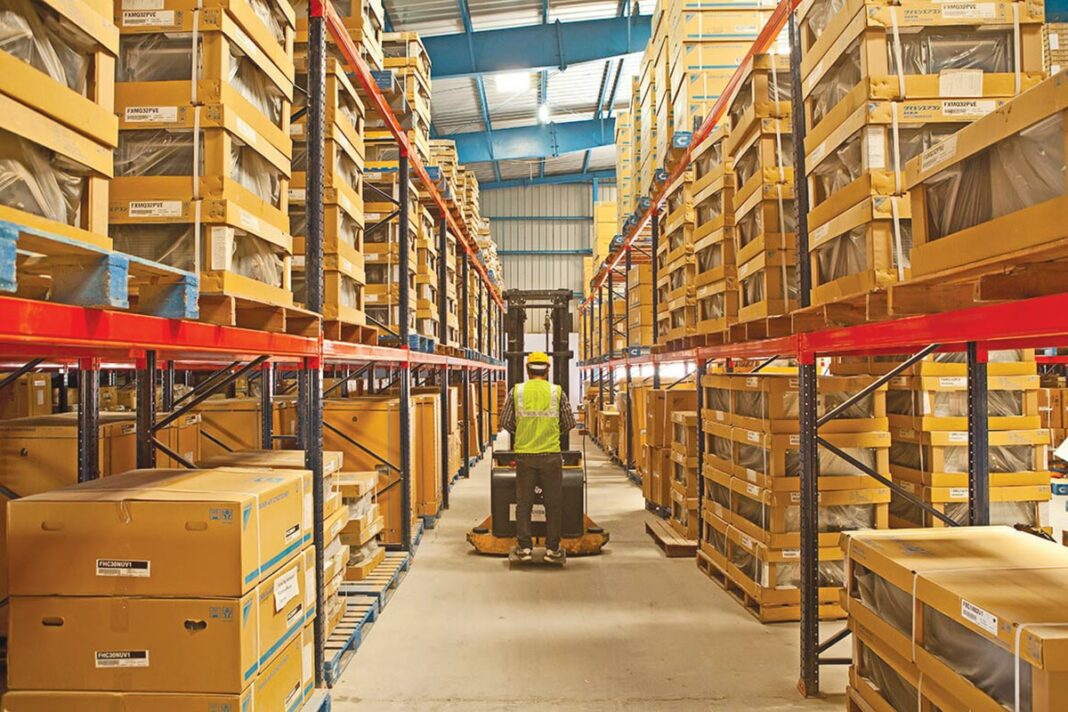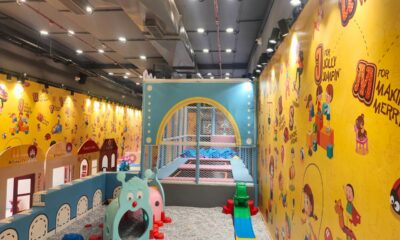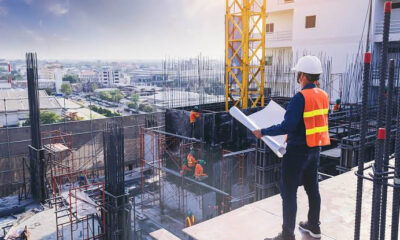News
Retail emerges as one of the key drivers for warehousing demand over a 5-yr period


September 27, 2023: CBRE South Asia Pvt. Ltd., has released a report, ‘The Three-mile Tale: Dissecting The New-age Retail Supply Chain Network’, at the CII Realty 2023 conclave in New Delhi. The report delves into the evolving landscape of retail warehousing in India, offering insights and a forward-looking roadmap for the industry.
As per the report’s findings, the collective warehousing demand for e-commerce, FMCG, and retail sectors have accounted for nearly 27% of the total demand in the 2019-H1 2023 period. Within the retail sector domain, hypermarkets (51%) and fashion & apparel (32%) companies dominated the share in warehousing demand. Notably, the share of retail in total demand has increased from 8% in 2019 to 13% in 2022. Although it touched 9% in H1 2023 and is expected to strengthen in H2 2023 backed by an anticipated increase in consumption during the festive season. As consumer expectations evolve, retailers recognize the efficiency and advantages associated with investing in supply chain transformation. Therefore, going forward, a strong warehousing demand is expected from retailers especially those with omnichannel fulfilment requirements.
Post the pandemic, an increased expansion of e-commerce has led several retailers to embrace an omnichannel retail strategy. The adoption of this strategy requires a complete overhaul of a retailers’ business, from advertising and merchandising to payment, fulfilment, and delivery. A successful omnichannel retailer will offer a seamless shopping experience which is consistent across all channels, whether online, social media, or in-store. Retail market in India has undergone a huge transformation due to the proliferation of retailers, expansion of stores, and rapid uptake in online shopping. Access to social media and e-commerce platforms has bridged the information gap and created a wider shopper network. An increase in the disposable income of consumers, coupled with these factors, is likely to boost India’s retail market.
India’s per capita income is expected to rise from USD 2,278 in 2022 to USD 5,242 in 2031, which will aid discretionary spending further, and most income brackets will have more to spend on discretionary items. Between 2022-2030, consumer spending across discretionary categories such as clothing and footwear, recreational and cultural services along with restaurants and hotels are expected to grow by 1.6x, 2x and 2.3x respectively. The confluence of these factors is likely to result in the continued growth of the retail sector in the upcoming years.
Key trends impacting retailers’ warehousing strategies:
| S. No. | Trends |
| 1 | Growth in e-commerce:Proliferation of e-commerce during the pandemic led retailers to optimize their warehousing strategies for efficient online order fulfilment resulting in the surge of distribution centres and last-mile delivery hubs. |
| 2 | Technology – an enabler:Innovation in robotics such as automated picking systems, robotic sorting and autonomous vehicles for material handling have enabled warehouses to streamline their operations. |
| 3 | Multi-channel fulfilment needs:Seamless integration of offline and online channels necessitating implementation of warehousing solutions that can manage diverse inventory types and accommodate various fulfilment methods. |
| 4 | Heightened demand for 3PL services:Rising demand from e-commerce and direct-to-consumer (D2C) brands which exerts immense pressure on 3PLs to meet a wide array of customer demands spurring the emergence of multi-tenanted warehousing facilities. |
| 5 | Democratization of data analytics:Data analytics not only empowering retailers to transform information into meaningful insights and formulate effective go-to-market strategies but also enabling optimization of inventory management, demand forecasting and enhancement of overall warehouse operations. |
| 6 | Need for bolstering supply chain resilience:Retailers expanding the scope of warehousing networks in a bid to provide flexible pickup and delivery options, while simultaneously mitigating the susceptibility of supply chain networks to external disruptions. |
| 7 | Demand for sustainable solutions:Sustainable prerogative encouraging retailers and landlords to adopt energy-efficient warehouse designs, green transportation methods, renewable energy solutions, and responsible sourcing of materials. |
As per the report findings, the retail sector, across categories is poised to witness accelerated growth. The fashion and apparel category is anticipated to expand by over 12 times by 2047. This growth will necessitate adaptable storage solutions capable of accommodating shifting inventory requirements driven by seasonal fluctuations. The FMCG category is projected to grow nearly six-fold by 2027. To support this expansion, temperature-controlled storage facilities will be essential to maintain product quality. Additionally, automated First-In-First-Out (FIFO) rotational methods within warehouses will be crucial to prioritize the sale of older products first, minimizing wastage. The consumer electronics category is anticipated to witness a 1.5-fold increase by 2027. To enable this growth, measures like anti-static flooring, specialized packaging, and handling procedures are essential to prevent damage from electrostatic discharge. Warehouses will need to also adhere to specific standards and regulations to safely store lithium batteries and other hazardous electronic materials and components. The beauty & personal care category is poised for a 1.7-fold growth by 2027. To support this expansion, it is imperative to have controlled environments for temperature and humidity to prevent product degradation. Warehouses must also provide facilities for delicate product handling, including dust-free areas that may require sterile conditions.
The report highlights various technological breakthroughs that continue to enable retail businesses to execute logistics operations with higher efficiencies, lower costs and greater flexibility based on seasonal demand. Listed below are a few key new-age technologies that are likely to play a pivotal role in the future of warehousing and logistics:
- In the realm of warehouse and distribution centers, advanced technologies play a focal role in streamlining operations. Automated storage and retrieval systems (AS/RS) utilize computer-controlled systems to optimize order fulfilment and material handling processes. Automated Guided Vehicles (AGVs) are deployed for the warehouse inventory transportation, relying on sensors, tracks, and magnetic strips integrated into warehouse floors for navigation. Additionally, the introduction of cobots, semi-autonomous robots, has revolutionized warehouse tasks by working alongside human employees to execute precision-oriented or heavy-lifting activities. These innovative technologies collectively contribute to heightened productivity and efficiency in warehouse operations.
- In the realm of order packaging, various technologies come into play to enhance the process. Robotic arms and grippers are employed for accurate and automated order selection and packaging. Additionally, blockchain technology plays a fundamental role by verifying product authenticity, ensuring traceability, and implementing quality control through sensors, especially for time and temperature-sensitive goods. Furthermore, blockchain enables the use of smart contracts, automating packaging instructions, labelling requirements, and even facilitating automatic payments when predefined conditions are satisfied. These innovations collectively contribute to more efficient and reliable order packaging procedures.
- In the realm of dispatch and delivery, various technologies are indispensable. Real-time tracking via GPS and mobile apps allows live monitoring of shipments. Drones enable rapid deliveries in urban and remote areas. Delivery bots, designed for smaller goods, navigate sidewalks and streets, transforming the delivery process for speed and precision. These technologies collectively revolutionize the dispatch and delivery processes, ensuring speed and precision in the movement of goods.
- In the realm of reverse logistics, essential technologies come into play. IoT sensors ensure the quality of returned items, particularly those sensitive to temperature, time, humidity, and shock. AI and machine learning analyze data from returns to detect patterns and reasons for return, aiding decisions on restocking, refurbishing, or recycling.


Commenting on the report, Anshuman Magazine, Chairman and CEO, India, South East Asia, Middle East and Africa, CBRE, emphasized, “India’s retail landscape is undergoing an unprecedented shift, owing to a surge in retailers, store expansion, and rapid growth in online shopping. The convergence of social media and e-commerce platforms has enabled an extensive online purchasing ecosystem. Evolving consumer preferences and expectations coupled with a shift in the social fabric, rapid technological advances, complex trade dynamics, and stricter compliance regulations, including sustainability, are key aspects creating a stir in the retail segment. Retail players are trying to stay agile and nimble by reassessing their supply chains, which has led to a rise in demand for warehouse leasing and advanced warehousing solutions.
Furthermore, urbanization, increased disposable income, post-pandemic supply chain restructuring, and successful new brand launches are nudging retailers to streamline their business and explore the untapped tier-II, III, and IV markets for both stores and warehousing.”


Rami Kaushal, Managing Director Consulting & Valuation Services, India, Middle East & Africa, said, “The robust demand and growth witnessed is retail warehouse leasing across organized spaces such as high-quality malls, prime high streets, and standalone developments is a testament to the rapid expansion being witnessed in the retail sector. The massive boom in Q-commerce for quick delivery of food, goods, and services, coupled with the rapid penetration in e-commerce, especially expanding to tier 2 and 3 cities, has led to a surge in demand for retail warehouses. With fashion & apparel, homeware, department stores, and hypermarkets consistently driving substantial demand, it’s evident that retailers are adapting to changing consumer preferences. We are also witnessing a shift toward omnichannel retailing, emphasizing a seamless shopping experience across diverse platforms.”
Modern Grade A warehouses are gaining prominence in the continually changing retail landscape. Retailers are expected to increasingly adopt these advanced facilities in the future as they seek enhanced efficiency, flexibility, and reliability in their supply chain operations.
Key Retail Warehousing Trends poised to align with expanding retail demand:
Resilient demand –
- Retail occupiers’ warehousing demand is expected to stay strong, driven by their adoption of a ‘multipolar’ supply chain strategy and ongoing government efforts to enhance logistics infrastructure and investments.
- Retail occupiers will likely persist in prioritizing multi-sourcing and nearshoring strategies to address the rapidly growing market demands.
Robust Supply –
- Developers are likely to focus on constructing new age warehouses with maximum technology integration to attract ‘flight-to-quality’ leasing
- Warehousing facilities with features such as high ceilings to accommodate automated stacking systems, sufficient loading / unloading zones and power back-up provisions are likely to gain more traction across retail categories
- Multi-level warehouses would be a preferred option to overcome challenges related to urban logistics in densely populated megacities with competitive land prices
ESG Integration –
- ESG takes center stage in retail warehousing as companies commit to decarbonization and carbon neutrality, shifting from an option to a project’s competitiveness marker
- Collaboration with occupiers to ensure intertwined decarbonisation strategies would become a key priority for developers
Growth beyond Tier-I cities –
- Rising urbanisation, increase in per capita income, supply chain revamp after the pandemic and successful brand launches in tier-II, III and IV markets have led retailers to explore these emerging untapped locations to set up store as well as for warehousing requirements
- Retail occupiers would prioritise prime locations closer to consumption hubs for expansion, but the non-availability of ready-to-move-in supply would shift their focus towards secondary / tier-II locations, which would also enable them to leverage comparatively low rentals.
-



 News4 weeks ago
News4 weeks agoKW Delhi 6 Mall Onboards New Brands
-



 News4 weeks ago
News4 weeks agoCommercial Realty Gets Tech Savvy: Fast Construction, Enhanced Convenience
-



 News3 weeks ago
News3 weeks agoGodrej Properties Sells Rs 3k cr+ Homes of Godrej Zenith, Gurugram, within 3 days
-



 News3 weeks ago
News3 weeks agoRBI’s Status Quo on Key Policy Rates to Help Maintain the Real Estate Growth Momentum, Say Industry Stalwarts
-



 News2 weeks ago
News2 weeks agoOlive Announces Dhruv Kalro as Co-Founder
-



 News1 week ago
News1 week agoNoida’s High-Rise Societies Face Multiple Challenges Despite Rapid Urban Growth
-



 News3 weeks ago
News3 weeks agoGodrej Properties Sells 5000+ Homes of Rs 9.5 cr in Q4FY24, Bookings up 84% YoY
-



 News2 weeks ago
News2 weeks agoVestian: Domestic Investors Dominate Institutional Investments in Jan-Mar’24
















